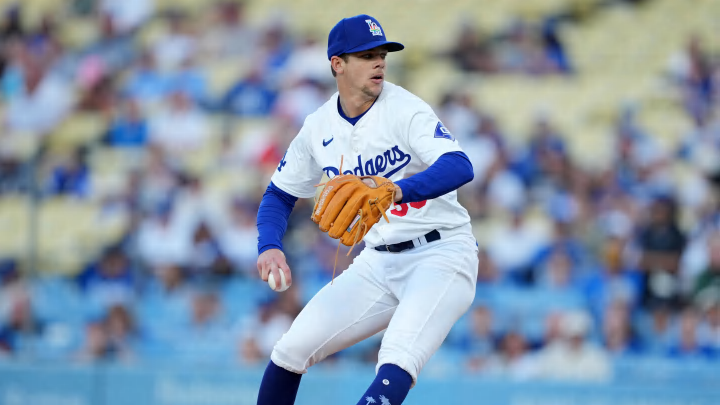Rookie Starters Have Kept Injury-Stricken Dodgers on Course

Welcome to the Rookie Roundup, a weekly look-in on baseball’s best and most interesting first-year players. Last week, we took a look at which American League rookies would have the biggest impacts on the second half playoff race. Next up is a look at how the Dodgers have leaned on rookie arms to buoy their championship aspirations.
On a day when future Hall of Famer Clayton Kershaw made his long-awaited season debut, it was a different group of players that Los Angeles Dodgers manager Dave Roberts referred to while evoking a higher power.
“Collectively,” Roberts said Thursday of his team’s rookie starting pitchers, “they’ve been a godsend for our ball club.”
Sent from above? Maybe not. But for a first-place team that’s been hammered by injury after injury to its rotation, the Dodgers have plenty to be thankful for in regards to their rookie arms.
Entering play Monday, the Dodgers lead the majors in innings logged by rookie starting pitchers (254 1/3). That group of six—Gavin Stone, Yoshinobu Yamamoto, Landon Knack, Justin Wrobleski, Kyle Hurt and River Ryan—also ranks first in wins (18) and fWAR (4.4), and second in ERA (3.04). One of the league’s deepest-pocketed teams getting top-flight production from a collection of first-year players has been a critical development in the team holding a 6.5 game lead in the NL West, which it’s aiming to win for the 11th time in the last 12 years.
Of that cohort, Yamamoto, of course, stands out. By virtue of his decorated career pitching in Japan and the record-setting $325 million contract signed this winter, he is not a typical rookie. But the 25-year-old has been out since mid-June on the injured list, which has been populated by one Dodgers pitcher after another through the season’s first four months.
A rotation that once ranked among the deepest in the league has seen key arms drop like flies. Michael Grove hit the IL the same day as Yamamoto. Righthander Walker Buehler joined a few days later. Tyler Glasnow spent most of July on the IL before being activated on Wednesday. Free-agent pickup James Paxton was designated for assignment on July 22, just days before the team announced Hurt—one of its top prospects—would need Tommy John surgery.
Combine that with Bobby Miller’s struggles and Kershaw’s prolonged absence, and Los Angeles has needed all the help it could get on the mound. While Yamamoto largely lived up to the hype that preceded his arrival, the rest of the rookies were more anonymous and unproven prior to being forced into action this season. And though it’s been an all-hands-on-deck type of mentality, Stone has stood out the most among the young arms.
A fifth-round pick out of Central Arkansas in the pandemic-abbreviated 2020 draft, Stone made his major league debut last year, logging 31 innings with a 9.00 ERA. He’s grown up in a hurry in 2024, blossoming into a staff workhorse for a club with the National League’s second-best record.
“We’ve needed guys to step up. We’ve had injuries, and needed guys to eat innings and give us starts, and that’s what they’ve done,” catcher Will Smith says. “[Stone] pitched a little last year for us, this year he’s taken another step. He’s been really, really good for us.”
The results speak for themselves. Stone has thrown the second-most innings of any rookie pitcher (107 2/3), trailing only Shōta Imanaga of the Chicago Cubs. He leads all National League rookies with 10 wins, ranks fifth among those with at least 10 starts in ERA (3.34) and is fourth among rookie starters in win probability added (1.20). In a year when Pittsburgh Pirates ace Paul Skenes has deservedly dominated the rookie conversation, Stone has been right there in terms of importance to his team.
Even more than the results, Stone has impressed his peers with a wise-beyond-his-years style of preparation, which he attributes to the organization’s coaches and coordinators as well as observing older teammates like Kershaw. It’s that attention to detail in between outings that draws the most praise from the veterans.
“He’s always the same dude,” Glasnow says of Stone’s routine. “His work week is always very consistent. Pitching-wise, his rhythm and his mechanics are always very much the same. He’s a lot more mature than most young guys.”
He’s not the only rookie chipping in, though. Knack has a 2.72 ERA over eight starts, and Ryan—viewed as one of baseball’s top pitching prospects—fired 5 1/3 innings with no earned runs allowed in his big league debut on Monday, then took a no-hitter into the fifth inning and picked up his first career win in Sunday’s 6–2 victory over the Houston Astros.
“They just attack,” Smith says of what’s impressed him most about the rookie starters. “They don’t seem scared at all, they don’t seem anxious.
“Maybe a little anxious,” he concedes. “But they’re just going to attack hitters and try to get outs, and that’s what they’ve been doing.”
Nerves are natural for any young player, but Stone has displayed a preternatural ability to convey calm while navigating the start of his career and playing a key role in the playoff hunt.
“You can’t really think about it too much. It’s a surreal moment because this is something you dream of when you’re a little kid, being in a [playoff] race, possibly a chance to win a World Series,” Stone says. “So it’s really cool to be in this situation, but you try not to think about it too much. Just go out and put up zeroes.”
Stone credits the Dodgers’ development system and approach to pitch mixing with his success, particularly in regard to his offspeed pitches. His changeup has been his best offering, generating a .187 batting average against. By Statcast’s run value measure, it’s been among the most effective changeups in the game.
Beyond mechanical and strategic tweaks, Stone points to the team’s leadership as being crucial in creating a welcoming environment for a crop of young players still acclimating to life in The Show, something Glasnow says has been a welcomed shift in MLB clubhouse culture.
“I think a lot of it’s changed now, but I think before, coming up, [rookies] would feel uncomfortable. When you are a rookie, you don’t want to step on anyone’s toes,” Glasnow says. “And I think sometimes you can almost change up what you’re doing because you’re worried about what other people are thinking. But I don’t think that’s really the case here, and I think a lot of guys can come up and it’s a very friendly environment for anyone.”
In today’s game, with more specialized roles than ever and a rash of injuries—particularly to pitchers—necessitating more frequent roster churn, getting to know new teammates can be particularly challenging. But it’s something Dodgers veterans have placed an emphasis on as part of the relationship-building process.
“You just talk to them, get to know them. Show you care, show that they’re part of the team and here to help us win ball games,” Smith says. “It’s going to take time to get better relationships, that just comes with time. You can’t force that, but just talking to them, making them feel comfortable, and making them feel like you care.”
Kershaw’s return, combined with the steady progress of other injured pitchers, means that the cavalry is coming. And there remains time for the front office to add from outside the organization with Tuesday’s trade deadline looming large.
Even with reinforcements likely on the way, the contributions from a group most did not expect to be relied upon so heavily has enabled the Dodgers to be in this position—a fact not lost on their manager.
“They’ve been fantastic. If there was an MVP and you lump the rookie starting pitchers, they’d get a lot of first-place votes… We wouldn’t be where we’re at in the standings [without them], and they certainly wouldn’t have the confidence they have now, knowing that they can pitch in the big leagues and be viable options,” Roberts says. “As an organization, it’s been a big win having those guys develop here.”
